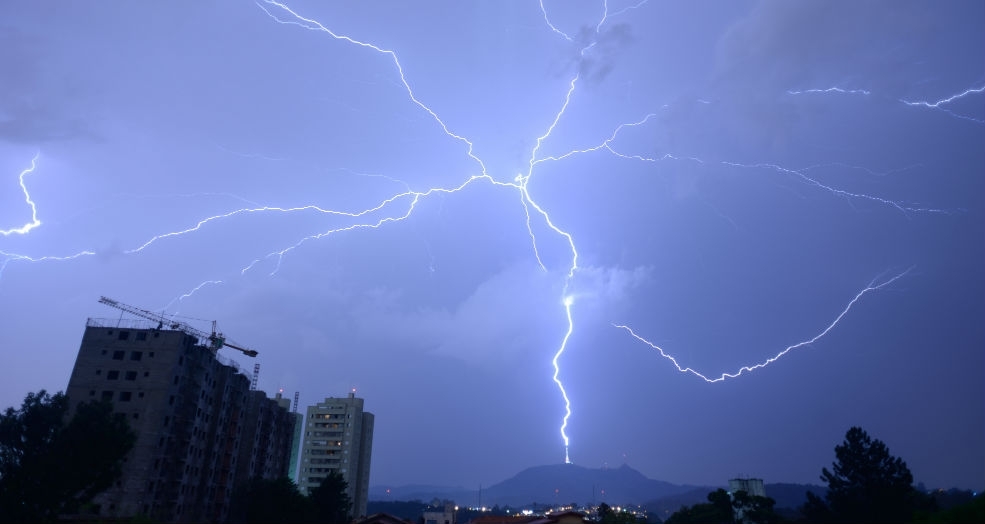

According to an article published in Scientific Reports, positively charged cloud-to-ground lightning strokes can trigger upward flashes from the tops of tall structures such as skyscrapers or wind turbines (photo: ELAT / INPE)
According to an article published in Scientific Reports, positively charged cloud-to-ground lightning strokes can trigger upward flashes from the tops of tall structures such as skyscrapers or wind turbines.
According to an article published in Scientific Reports, positively charged cloud-to-ground lightning strokes can trigger upward flashes from the tops of tall structures such as skyscrapers or wind turbines.

According to an article published in Scientific Reports, positively charged cloud-to-ground lightning strokes can trigger upward flashes from the tops of tall structures such as skyscrapers or wind turbines (photo: ELAT / INPE)
By Elton Alisson | Agência FAPESP – In recent years, scientists in Brazil have begun systematically observing and recording upward lightning strikes. These unusual strikes start from a tall building, tower or wind turbine and propagate upward to the overlying cloud, whereas most lightning strikes are cloud-to-ground electrical discharges.
Members of the Atmospheric Electricity Group (ELAT) at the National Space Research Institute (INPE) produced the first videos of upward lightning in Brazil and have now succeeded in elucidating the mechanisms involved in their formation.
Findings from the study, which was part of a project supported by FAPESP, have been published in Scientific Reports.
The investigation took place while Carina Schumann was conducting doctoral research at INPE supported by a scholarship from FAPESP.
“We found that upward leaders originate at the top of a tower or the lightning conductor on a skyscraper, for example, just after a cloud-to-ground discharge and as far away as 60 kilometers,” Marcelo Magalhães Fares Saba, a researcher at INPE and principal investigator for the project, told Agência FAPESP.
Between 2011 and 2016, the group observed and recorded 110 upward flashes during summer thunderstorms on Mount Jaraguá, the highest point in São Paulo City (Brazil), and in Rapid City, South Dakota (USA).
The researchers used a combination of digital still cameras, standard video cameras, and high-speed cameras capable of recording between 1,000 and 35,000 images per second as well as electric field meters, lightning mapping arrays, and an ultrahigh-speed camera capable of recording up to 100,000 images per second.
Cameras with unusually fast image acquisition speeds are required for this type of study because upward flashes and cloud-to-ground discharges last only a few hundred milliseconds and cannot be distinguished without such equipment, according to Saba.
“It wouldn’t be possible to produce such a series of observations of upward leaders in a sufficient number to understand how they originate without the aid of high-speed and ultrahigh-speed cameras,” he said.
The results of the analysis, together with the electric field meter data, showed that upward lightning flashes are often triggered by downward discharges that leave a net negative charge in the cloud. These positively charged cloud-to-ground strikes typically occur at the end of a thunderstorm. Shortly after such a discharge touches the ground, a continuing low-intensity current remains. This current produces a rapid sharp disturbance in the storm cloud charge distribution, creating the necessary conditions for an upward flash.
“Positive cloud-to-ground flashes produce a negative discharge inside the cloud, with a horizontal extent of many kilometers,” Saba said. “These negative discharges can pass over tall towers and induce positive discharges at the tops of the towers. If an induced electric charge is intense enough, it can trigger a discharge from the top of the tower. That’s what we call upward lightning.”
More upward lightning strikes have been recorded on Mount Jaraguá than anywhere in the world except for a location in the Swiss Alps.
The summit is 1,135 m above sea level and sees 30-40 upward discharges per year, mainly in summer but also in winter when cold fronts pass over the area, according to Saba.
“We’ve recorded upward flashes from Mount Jaraguá during the winter, but they’re more frequent during the transitions from spring to summer and summer to fall,” he said.
Damage to structures
Downward lightning is much more common than upward lightning, according to the researchers. Both types are equally intense, but upward discharges usually last 40% longer. They are not hazardous to people because they originate at the tops of tall structures. However, while the impact of cloud-to-ground lightning is more spread out – statistics show that one single discharge touches different points on the surface in half the cases – the impact of an upward flash is concentrated at the top of a tall structure, which can be damaged as a result.
“We’ve found that structures with a height of over 70 m will tend to produce upward strokes,” Saba said.
Given the growing number of skyscrapers and other tall structures in cities like São Paulo, the number of upward lightning strokes will also tend to rise, in his view. “Upward lightning wouldn’t exist without tall structures,” he said.
The researchers are now studying how lightning conductors respond to downward discharges, since an upward discharge may be triggered to connect with a downward one as it approaches.
“This can be important for defining the area protected by a lightning conductor, for example,” Saba said.
The Scientific Reports article “On the triggering mechanisms of upward lightning” (doi: 10.1038/s41598-019-46122-x) by Carina Schumann, Marcelo M. F. Saba, Tom A. Warner, Marco A. S. Ferro, John H. Helsdon Jr., Ron Thomas and Richard E. Orville can be read at www.nature.com/articles/s41598-019-46122-x.
Republish
The Agency FAPESP licenses news via Creative Commons (CC-BY-NC-ND) so that they can be republished free of charge and in a simple way by other digital or printed vehicles. Agência FAPESP must be credited as the source of the content being republished and the name of the reporter (if any) must be attributed. Using the HMTL button below allows compliance with these rules, detailed in Digital Republishing Policy FAPESP.





